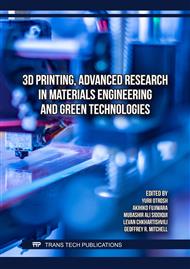[1]
W. Bai et al., "Academic Insights and Perspectives in 3D Printing: A bibliometric review," Applied Sciences, vol. 11, no. 18, p.8298, Sep. 2021.
DOI: 10.3390/app11188298
Google Scholar
[2]
D. Rosato and D. Rosato, "DESIGN OPTIMIZATION," in Elsevier eBooks, 2003, p.46–160.
DOI: 10.1016/b978-185617416-9/50003-x
Google Scholar
[3]
Kabir, S. M. F., Mathur, K., & Seyam, A. M. (2020). Impact resistance and failure mechanism of 3D printed continuous fiber-reinforced cellular composites. the Journal of the Textile Institute/Journal of the Textile Institute, 112(5), 752–766.
DOI: 10.1080/00405000.2020.1778223
Google Scholar
[4]
E. Yang, S. Miao, J. Zhong, Z. Zhang, D. K. Mills, and L. G. Zhang, "Bio-Based polymers for 3D printing of bioscaffolds," Polymer Reviews, vol. 58, no. 4, p.668–687, Sep. 2018.
DOI: 10.1080/15583724.2018.1484761
Google Scholar
[5]
S. RameshKumar, P. Shaiju, K. E. O'Connor, and R. B. P, "Bio-based and biodegradable polymers - State-of-the-art, challenges and emerging trends," Current Opinion in Green and Sustainable Chemistry, vol. 21, p.75–81, Feb. 2020.
DOI: 10.1016/j.cogsc.2019.12.005
Google Scholar
[6]
E. R. R. Ghomi et al., "The life cycle assessment for Polylactic Acid (PLA) to make it a Low-Carbon material," Polymers, vol. 13, no. 11, p.1854, Jun. 2021.
DOI: 10.3390/polym13111854
Google Scholar
[7]
T. M. Joseph et al., "3D printing of polylactic acid: recent advances and opportunities," the International Journal of Advanced Manufacturing Technology/International Journal, Advanced Manufacturing Technology, vol. 125, no. 3–4, p.1015–1035, Jan. 2023.
DOI: 10.1007/s00170-022-10795-y
Google Scholar
[8]
D. M. Kulich, S. K. Gaggar, V. Lowry, and R. Stepien, "Acrylonitrile–Butadiene–Styrene polymers," Encyclopedia of Polymer Science and Technology, Oct. 2001.
DOI: 10.1002/0471440264.pst011
Google Scholar
[9]
I. Cartagenas, "Thermal conductivity of ABS, Acrylonitrile Butadiene Styrene," Thermtest, Nov. 22, 2022. https://thermtest.com/thermal-conductivity-of-acrylonitrile-butadiene-styrene-abs?utm
DOI: 10.3403/bs5391
Google Scholar
[10]
I. Turku, S. Kasala, and T. Kärki, "Characterization of feedstock filament extruded from secondary sources of PS, ABS and PVC," Preprints.org, Oct. 2018, doi: 10.20944/preprints201810. 0581.v1.
DOI: 10.20944/preprints201810.0581.v1
Google Scholar
[11]
Y. Kim, E. S. Choi, W. Kwak, and Y. Shin, "Analysis of the thermal distribution by using Laser-Beam irradiation," Journal of the Korean Physical Society, vol. 51, no. 2, p.503–508, Aug. 2007.
DOI: 10.3938/jkps.51.503
Google Scholar


